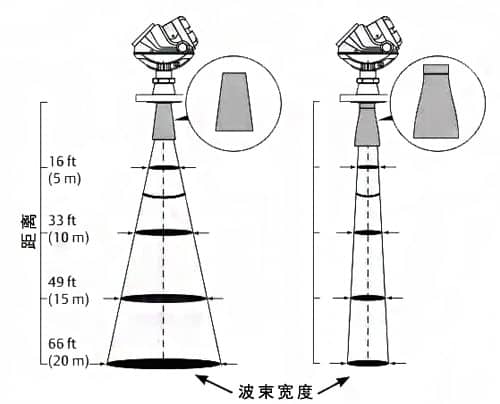what is the main difference between 26G and 80G radar ? working principle and cost ?
what is the advantages of each item for different applications ?
what will be the main factor that buyer cares about ?
The influence of high frequency and low frequency of radar liquid level sensor on measurement
1. The influence of frequency on measurement
The radar level sensor emits electromagnetic waves through an antenna, and the higher the frequency of the electromagnetic waves. The higher the energy of the electromagnetic wave and the shorter the wavelength, the more obvious the scattering phenomenon. Conversely, the lower the energy, the longer the wavelength, and the energy is not easily absorbed by the gas phase layer.
For an antenna of the same size, a level gauge with a wavelength of 1.2 cm and a frequency of 26 GHZ has 6 times higher gain than a level gauge with a wavelength of 3 cm and a frequency of 10 GHZ. (Note: Antenna gain is a parameter indicating the degree of concentration of directional antenna radiation).
The received signal diagrams of different frequencies (26, 10, 6 GHZ), the same antenna, dielectric constant and distance increase are as follows:

The total beam width of the radar level sensor is inversely proportional to the frequency of the device.
Therefore, for an antenna with the same diameter, if the frequency of the radar level sensor is increased, the beam width will be lower than that of a lower frequency device. The narrow beam minimizes the influence of the nozzle, tank wall and interference.
As shown in the picture (the left side is 6 GHZ, the right side is 26 GHZ).
At the same time, the measurement range of the radar liquid level sensor is also affected by factors such as frequency, antenna size, dielectric constant of the liquid, and process conditions.
2. The application difference between high frequency and low frequency of radar liquid level sensor
When measuring steam, foam, and condensate, choose low-frequency radar first. In most other applications, choose high-frequency radar first for ease of installation.
-
The lower frequency reduces the sensitivity to steam, foam and antenna contamination. The wave velocity angle of low frequency radar is wider. It can better deal with the problems of steam, dust, condensation, pollution and turbulent surfaces.
-
The higher frequency can minimize the impact on the nozzle, tank wall and interference.
FMCW 80G radar are more robust than 26G radar
1: the antenna is different as the 80G mm vawe radar working in 76-81GHz frequency. so the size of antenna is small than 26G Radar, and easy to installation.
2: Small beam angle, as the lenght of wave is 1/3 of 26GHz Radar so the beam taper angle can be controlled smaller, such as 3°
3: Lower power consumption , as the new antenna and new chip set used, the power consumption is less than 26GHz Radar.
4: low cost, Kacise KLD series 80G High Frequency Radar Level transimtter have more competitive price for the range of 120 meters to 5 meters